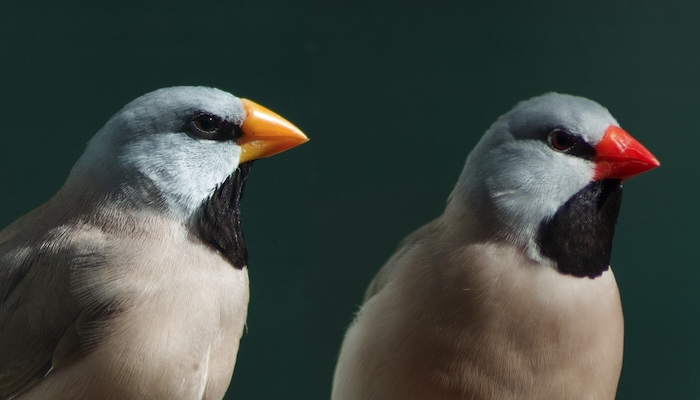What gives an Australian finch its brilliantly coloured red, yellow or orange bill? A major new study has uncovered the genetic switches controlling these distinctive colours, revealing a key piece in the puzzle of how animals develop their colouration.

Bright Bills: Red and yellow billed long-tail finches differ in how they process yellow pigment found in the seeds they eat. Image: Simon Griffith
The research published in Current Biology, reveals how yellow and red bill colours evolved in the long-tailed finch through changes in just a few key genes that control how birds process yellow pigments from their diet.
The study involved researchers from eight institutions across five countries, with the core research conducted by Dr Daniel Hooper from the American Museum of Natural History in New York and Professor Simon Griffith at Macquarie University in Australia where the species under investigation is found.
“Modern genomic techniques provide us with incredible insight into how relatively subtle genetic changes can lead to profound changes in things like animal colour,” says senior author Professor Simon Griffith, from Macquarie University’s School of Natural Sciences.
“Now, 165 years after Darwin first published his theory of evolution, we can see exactly how the frequency of these genes changes across populations over time.”
Mixing the colours
The study focused on two subspecies of the long-tailed finch found across northern Australia - one with a yellow bill based in the Kimberley region of Western Australia, and the other with a red bill from the Northern Territory. Where these subspecies meet, they produce hybrid offspring with orange bills.
This discovery helps us understand how animals can evolve different colour signals, contributing to the amazing colours of nature.
Most long-tailed finches in Australia today have bright red bills, with the colour coming from carotenoid (yellow) pigments in the seeds they eat. The birds produce enzymes that chemically turn the yellow pigments from their diet into red pigments which are deposited in their growing bills.
By analysing the DNA of over 900 finches, the researchers identified the exact genetic changes responsible for the different bill colours. They discovered that yellow-billed finches have genetic variations that prevent them from converting yellow dietary pigments into red ones.
“This discovery helps us understand how animals can evolve different colour signals, contributing to the amazing colours of nature,” says Professor Griffith.
When red-billed and yellow-billed finches mate, their offspring have orange bills. By studying the exact shade of orange in these hybrid birds, researchers could identify the different genes controlling bill colour.
These orange-billed hybrids occur naturally in a narrow region just west of Katherine in the Northern Territory.
Seeing Red
There’s another fascinating twist to the story. Birds use carotenoid pigments for decorative feather, skin and bill colours – but also for vision. These pigments are used in the retinas of their eyes, where tiny oil droplets containing carotenoids help filter light and enable colour vision.

In the field: Professor Simon Griffith, pictured, conducted research on the Australian finch in The Kimberley region of Western Australia and the Northern Territory.
This led to a key discovery. While yellow-billed finches don’t produce red carotenoids in their bills, they can still make them in their retinas.
“It's not that yellow-billed birds lack the genes for making red colouring; rather, they control these genes differently in different parts of their bodies,” Professor Griffith says.
The research team found evidence buried deep in the genome – the complete DNA code for the different forms - that the yellow bill colour, which first appeared around 100,000 years ago, provided some evolutionary advantage, allowing the genes for yellow bills to spread into populations of red-billed finches.
- One in three plants call islands home, now more than half are under threat
- The reason flowers wilt could explain how plants spend their energy
“While red-coloured bills were the ancestral state for these finches, we can see natural selection has favoured the yellow colouration as these populations have mixed,” Professor Griffith says.
“This tells us that having a yellow bill rather than a red one provided some benefit to these birds over many generations.”
The study provides new insights into how animal colouration evolves and may help explain similar colour variations seen in other bird species around the world.



